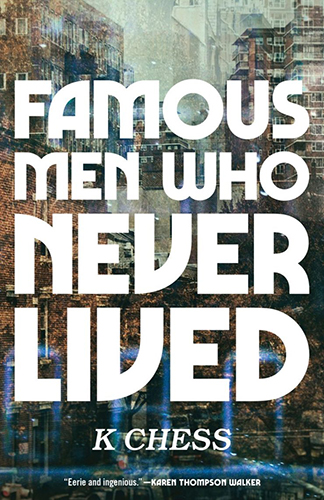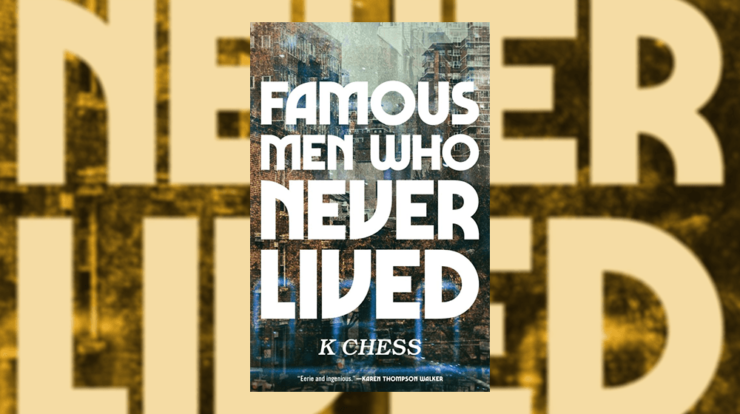A lot can happen in a century. No one knows this more than the 156 thousand Universally Displaced Persons (UDPs) that stepped through a rift in space-time to arrive in our timeline. The UDPs may have entered the twenty-first century alongside us, but their history—diverging from our own in around 1910—is another matter entirely. No longer are the Beatles, but instead Baccarat; KomSos instead of Nazis; a different New York by the same name: an entire alternative repertoire of slang, pop culture, politics, and technology. But now, trapped in a timeline so alike and yet so different from their own, that history simply never happened.
In K. Chess’ new novel Famous Men Who Never Lived, Helen Nash attempts to open a museum dedicated to the history lost during her migration. In particular, she wants to pay homage to Ezra Sleight, the author of a science fiction novel called The Pyronauts, and a man whose fate she is convinced is tied to the divergence of the timelines. Unlike her partner Vikram, Hel has no interest in assimilating or in learning about this strange new world that seems equal-parts repulsed by and indifferent to them. So when the only known copy of The Pyronauts goes missing, Hel will do whatever it takes to get it back.
At the novel’s start, Hel’s idea to open a museum to the titular famous men who never lived is just about to take flight: She has not only found the perfect location—Sleight’s childhood home, whose former tenant has recently passed away—but she’s also found the perfect benefactor. Ayanna Donaldson, an art curator, is intrigued enough by Sleight’s story and by Hel’s pitch, that she sends her assistant with Hel to begin collecting artifacts for the exhibit. When they’re unable to find a painting from Sleight’s childhood, though, Hel breaks down, convinced that her only chance at reconciling the timelines has slipped through her fingers. In her previous life, Hel was a doctor, a mother, a successful woman by any count, but in this timeline, without evidence of Sleight’s connection to the divergence, what is she? Who is she?
Her benefactor bows out, but not before—Hel is convinced—taking her copy of The Pyronauts.
Meanwhile, Hel’s partner Vikram attempts to make Sleight’s old home habitable again. Alongside his friend Wes and the current owner Dwayne, Vikram works and moves and cleans the space that he is sure will give Hel purpose again. Though Hel sees him as a beacon of stability and indifference in the face of their placelessness, Vikram wavers constantly between his desire to return and his resignation to their new reality. When, late one night at a storage facility, he sees the eerie light that signifies a gap between timelines, Vikram doesn’t hesitate to chase it down. So much for indifference.
Buy the Book


Famous Men Who Never Lived
Though Famous Men Who Never Lived tells Hel’s story, the novel itself belongs to UDPs as a class. Interspersed within Hel and Vikram’s points of view are excerpts from a number of publications, some named—The Pyronauts—and some uncataloged oral histories of other UDPs. Collectively, they make up a chronicle of life as a historically, spiritually, universally, displaced community, at once at home and away; together and alone. The novel in every way mimics the purpose of Hel’s museum, creating a space for empathy and understanding. Books and culture after all exist to provide context—just as The Pyronauts is the matter that makes up Hel’s life, so too does this novel make up ours.
Nevertheless, the refugee metaphor inherent to this novel is never overstated. Hel’s position as a white American is clear, with Vikram describing “It was the loss of her place in the top caste that had done this to her… She was a doctor. She was a white woman. She thought that if you followed all the rules, you’d eventually win the game.” The novel never felt appropriative of anybody’s story (though as a non-displaced person, I obviously can’t speak to this with authority). It dealt with the themes of a refugee story—including but not limited to grief and prejudice and existential placelessness—without ever claiming that Hel’s experiences are a universal refugee experience. In fact, the lives of each individual UDP are demonstrated as disparate, informed by their former lives, not just their current status.
I know I was not alone earlier this year when I mourned the closing of Tin House’s literary magazine arm. But this novel gives me hope for the publisher’s future, wrapped as it is in lush, literary prose in addition to its Sci-fi-rooted social commentary. Other reviewers have compared the novel to Emily St. John Mandel’s Station Eleven, and I have to agree, mostly due to its generous sense of ethics, and its hope in the role of art in society. In that vein, readers looking for a nail-biting mystery will not find one here: Famous Men Who Never Lived, like Station Eleven, is above all a meditation on grief and the preservation of culture, rather than a plot-driven page-turner. It is a beautifully-written and conceived novel, and one whose message of empathy across lines of difference is much-needed.
Famous Men Who Never Lived is available from Tin House.
Em Nordling reads, writes, and manages research in Louisville, KY.










